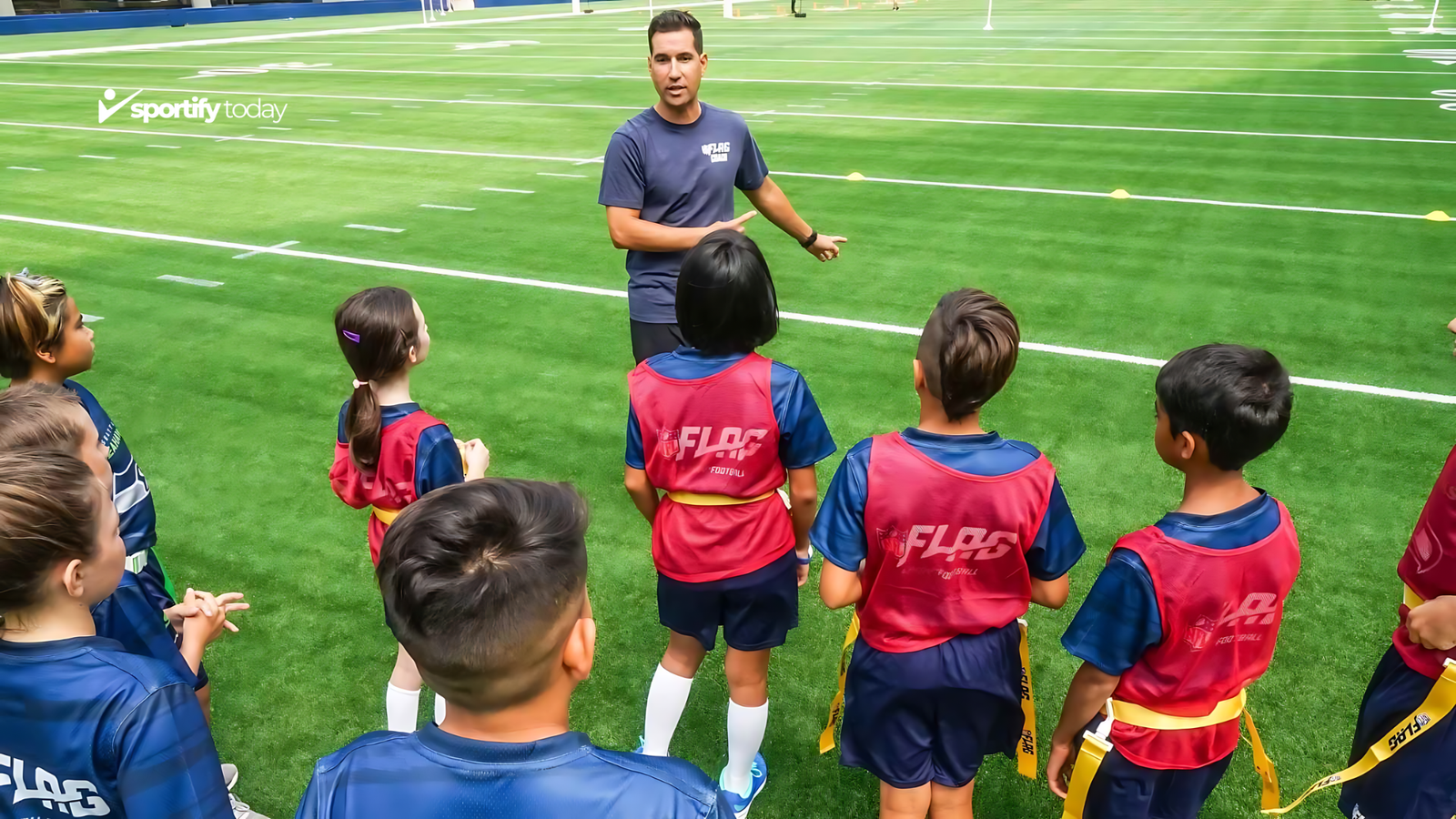
Introduction: Understanding the various positions in football (soccer) is crucial for players, coaches, and fans alike. Each position has specific roles and responsibilities that contribute to the team’s overall strategy and success. Below is a detailed position chart outlining the key football positions, their roles, and responsibilities.
Position Chart Summary

| Position | Abbreviation | Role Description |
|---|---|---|
| Goalkeeper | GK | Last line of defense, stops shots on goal |
| Right Back | RB | Defends right flank, supports attack |
| Center Back | CB | Central defender, blocks opposing attackers |
| Left Back | LB | Defends left flank, supports attack |
| Defensive Midfielder | CDM | Protects defense, breaks up opposition plays |
| Central Midfielder | CM | Links defense and attack, controls tempo |
| Attacking Midfielder | CAM | Creates goal opportunities, assists forwards |
| Right Winger | RW | Attacks from the right, delivers crosses |
| Left Winger | LW | Attacks from the left, creates chances |
| Center Forward | CF | Main goal scorer, holds up play |
| Striker | ST | Primary goal scorer, finishes chances |
1. Goalkeeper (GK)

The goalkeeper (GK) is the last line of defense, responsible for preventing the opposing team from scoring by saving shots on goal using any part of their body. They also organize the defense, communicate with teammates, and initiate attacks through effective distribution of the ball.
- Role: The last line of defense, responsible for stopping the opposing team from scoring.
- Key Responsibilities:
- Save shots on goal using any part of their body.
- Organize the defense and communicate with defenders.
- Distribute the ball effectively to start attacks.
2. Right Back (RB)
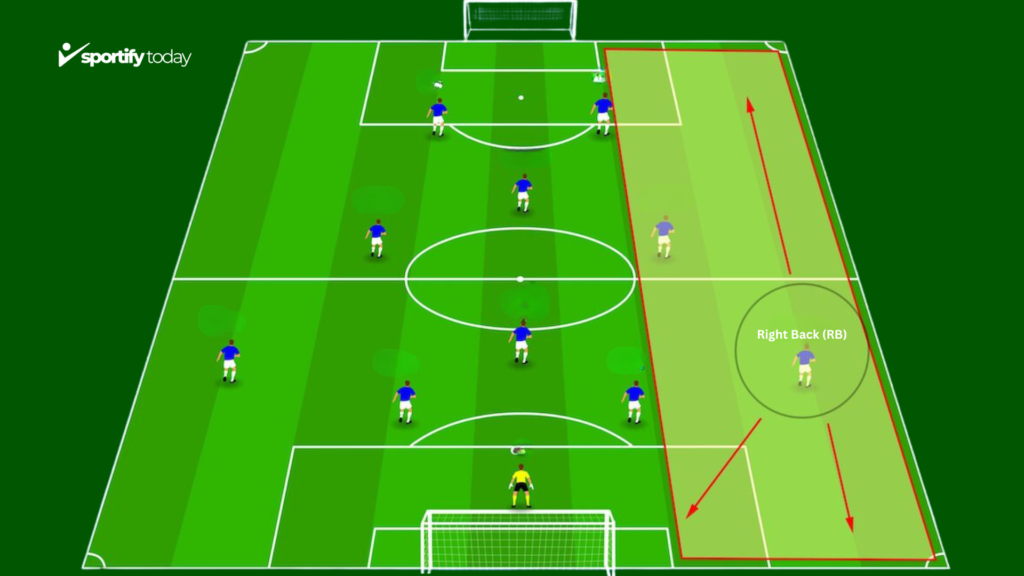
The right back (RB) is positioned on the right side of the defense, tasked with marking opposing wingers and preventing them from advancing. In addition to defensive duties, they support the attack by overlapping with right midfielders or wingers and delivering crosses into the opponent’s penalty area.
- Role: Positioned on the right side of the defense, tasked with defending against opposing wingers.
- Key Responsibilities:
- Mark and tackle opposing players on the right flank.
- Support the attack by overlapping with the right midfielder or winger.
- Deliver crosses into the opponent’s penalty area.
3. Center Back (CB)
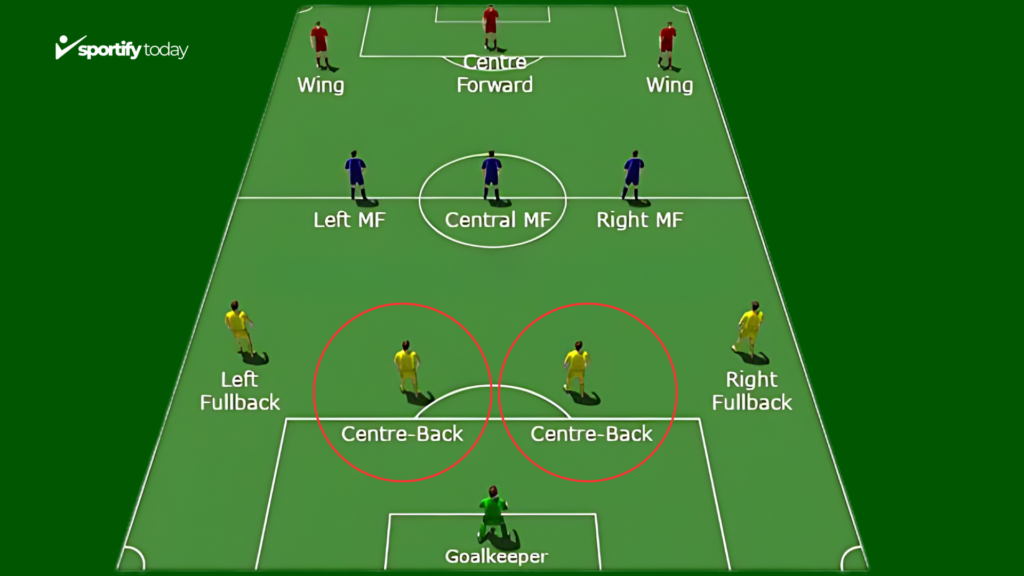
The center back (CB) is positioned centrally in the defense, responsible for blocking and intercepting attacks from opposing strikers. They play a crucial role in organizing the defensive unit, winning aerial duels during set pieces, and clearing the ball from the defensive zone to maintain team stability.
Role: Positioned centrally in defense, responsible for blocking and intercepting attacks.
- Key Responsibilities:
- Mark strikers and win aerial duels during set pieces.
- Clear the ball from the defensive zone.
- Organize the defensive unit and communicate with teammates.
4. Left Back (LB)
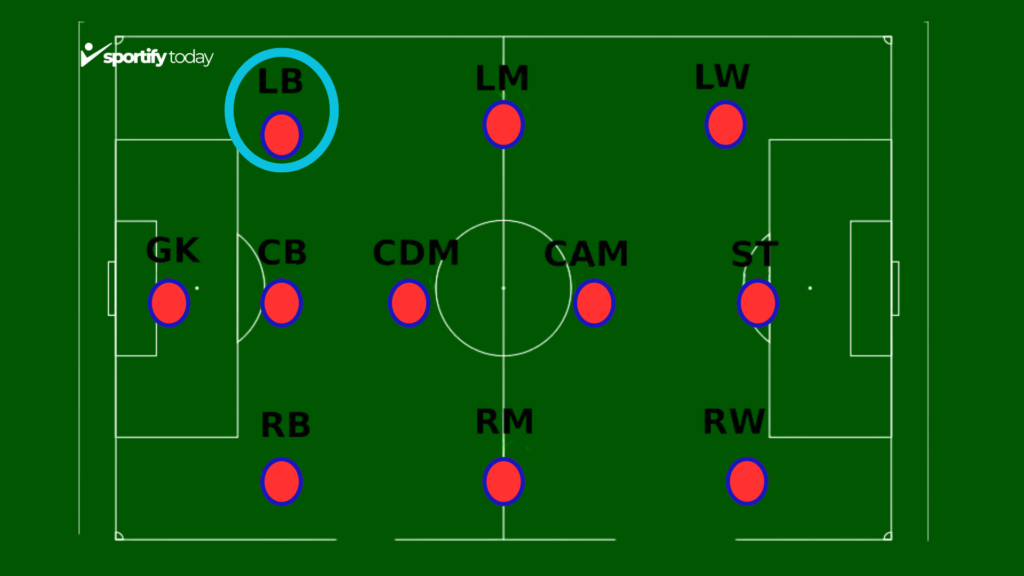
The left back (LB) is positioned on the left side of the defense, responsible for marking opposing players and preventing attacks down that flank. In addition to defensive duties, they support the team’s offense by overlapping with left midfielders or wingers and delivering crosses into the attacking zone.
- Role: Positioned on the left side of the defense, similar to the right back.
- Key Responsibilities:
- Defend against opposing players on the left flank.
- Support the attack by overlapping with the left midfielder or winger.
- Deliver crosses and provide width to the team’s attack.
5. Defensive Midfielder (CDM)
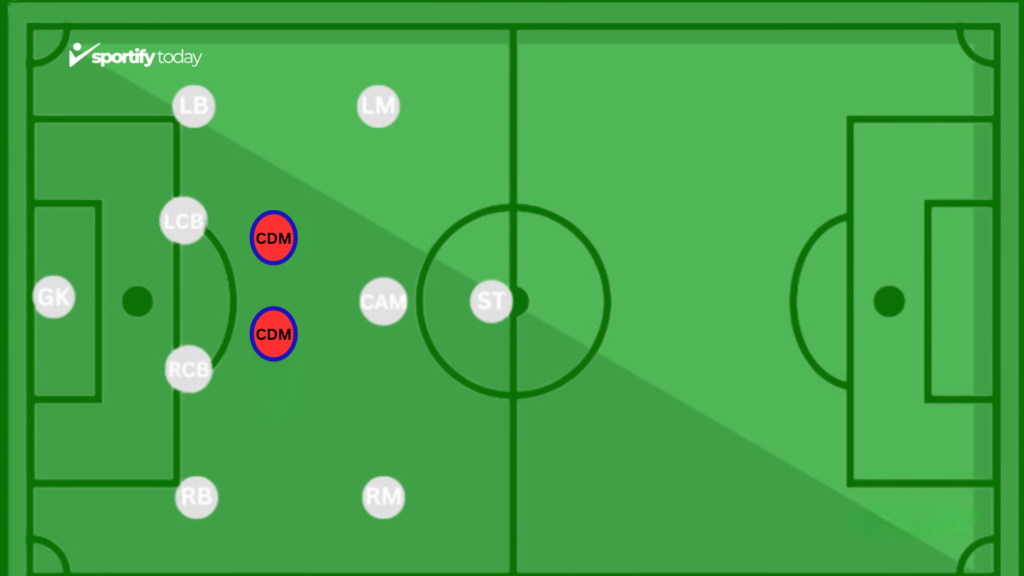
The defensive midfielder (CDM) is positioned in front of the defense, focusing on breaking up opposition attacks and providing cover for the backline. They play a key role in intercepting passes, tackling opponents, and distributing the ball to more advanced midfielders and forwards to initiate counter-attacks.
- Role: Positioned in front of the defense, focusing on breaking up opposition attacks.
- Key Responsibilities:
- Protect the backline by intercepting passes and tackling opponents.
- Distribute the ball to more advanced midfielders and forwards.
- Provide cover for defenders during counter-attacks.
6. Central Midfielder (CM)
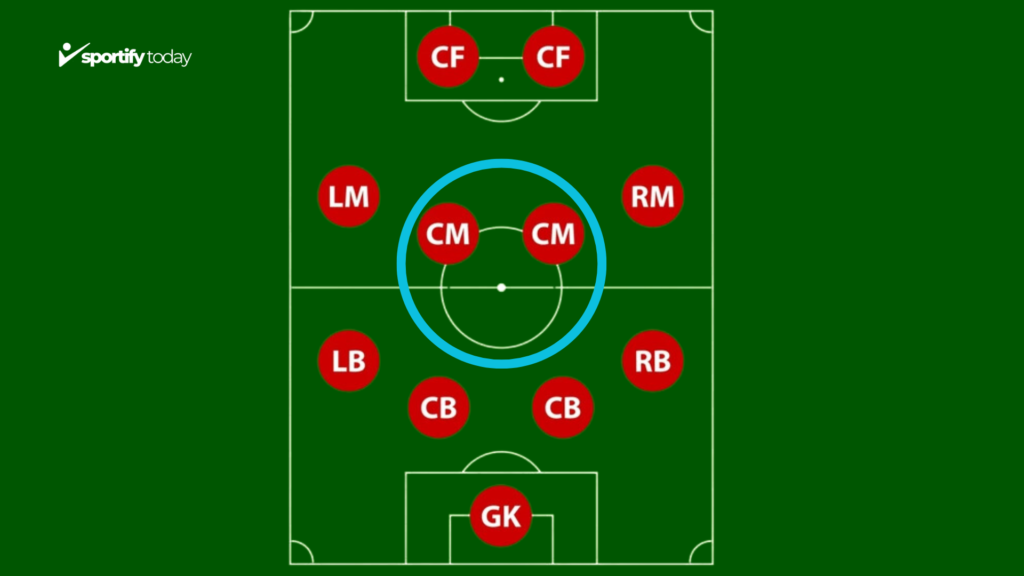
The central midfielder (CM) is positioned centrally on the field, acting as a link between the defense and attack. They control the tempo of the game, dictating play through effective distribution of the ball, and support both defensive and attacking phases of the game to maintain team balance and cohesion.
- Role: Positioned centrally, acting as a link between defense and attack.
- Key Responsibilities:
- Control the tempo of the game and dictate play.
- Support both defensive and attacking phases of the game.
- Distribute the ball effectively to wingers and forwards.
7. Attacking Midfielder (CAM)
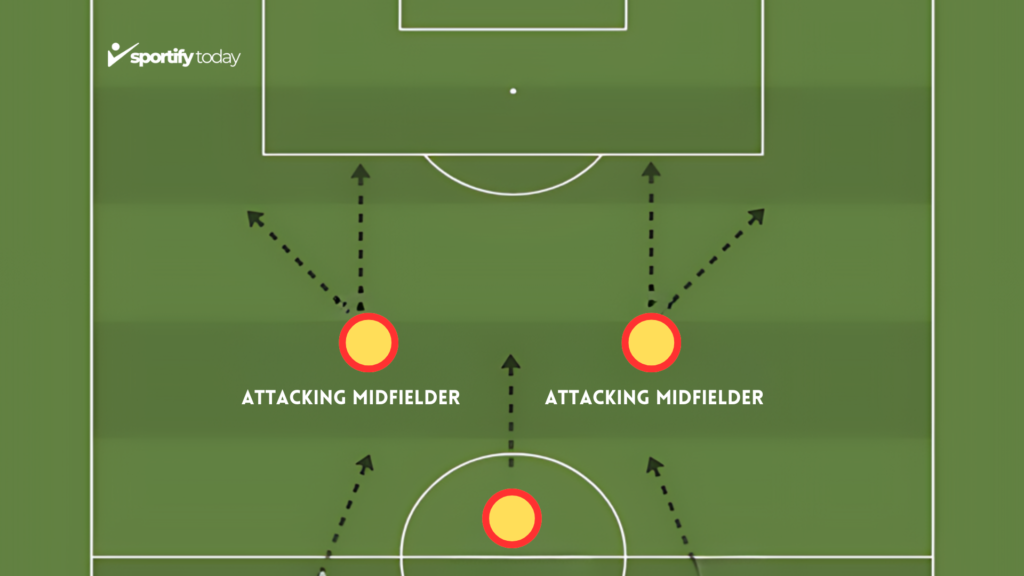
The attacking midfielder (CAM) is positioned closer to the forwards, focusing on creating goal-scoring opportunities and providing assists. They excel at finding space in the opposition’s defense, taking shots on goal, and linking play between midfield and attack to enhance the team’s offensive capabilities.
- Role: Positioned closer to the forwards, focusing on creating goal-scoring opportunities.
- Key Responsibilities:
- Provide assists to strikers and wingers.
- Take shots on goal from outside the box.
- Link play between midfield and attack, finding space in the opposition’s defense.
8. Right Winger (RW)

The right winger (RW) is positioned on the right flank, primarily responsible for delivering crosses and creating goal-scoring opportunities. They utilize their speed and dribbling skills to beat defenders, provide width to the attack, and cut inside to take shots or assist teammates.
- Role: Positioned on the right flank, focusing on delivering crosses and creating chances.
- Key Responsibilities:
- Beat defenders in one-on-one situations.
- Provide width to the attack and stretch the opponent’s defense.
- Cut inside to take shots or create opportunities for teammates.
9. Left Winger (LW)
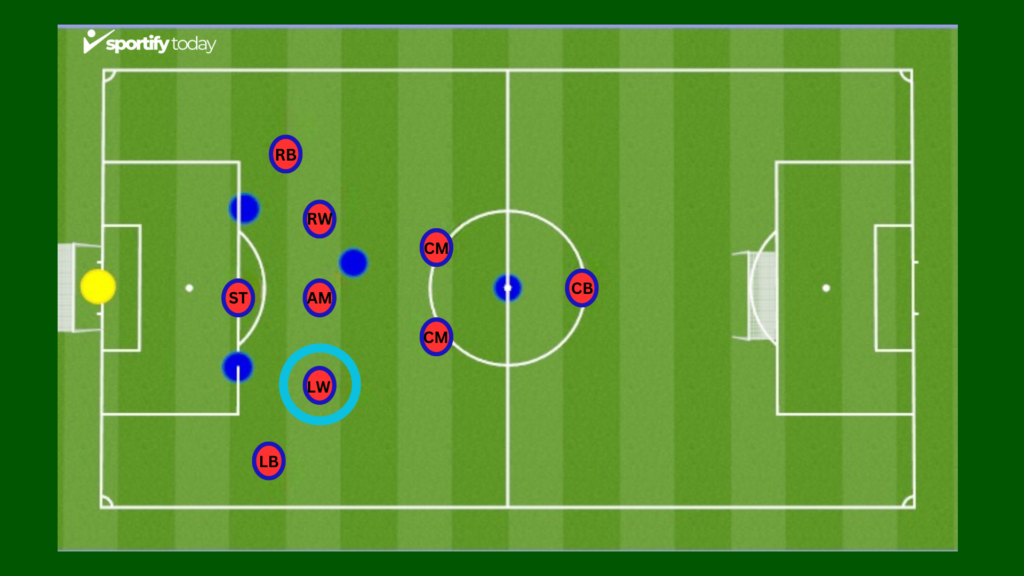
The left winger (LW) is positioned on the left flank, mirroring the role of the right winger. They attack from the left side, delivering crosses into the box, beating defenders in one-on-one situations, and cutting inside to take shots or create chances for the strikers.
- Role: Positioned on the left flank, similar to the right winger.
- Key Responsibilities:
- Attack from the left side, delivering crosses into the box.
- Beat defenders and create goal-scoring opportunities.
- Cut inside to take shots or assist strikers.
10. Center Forward (CF)
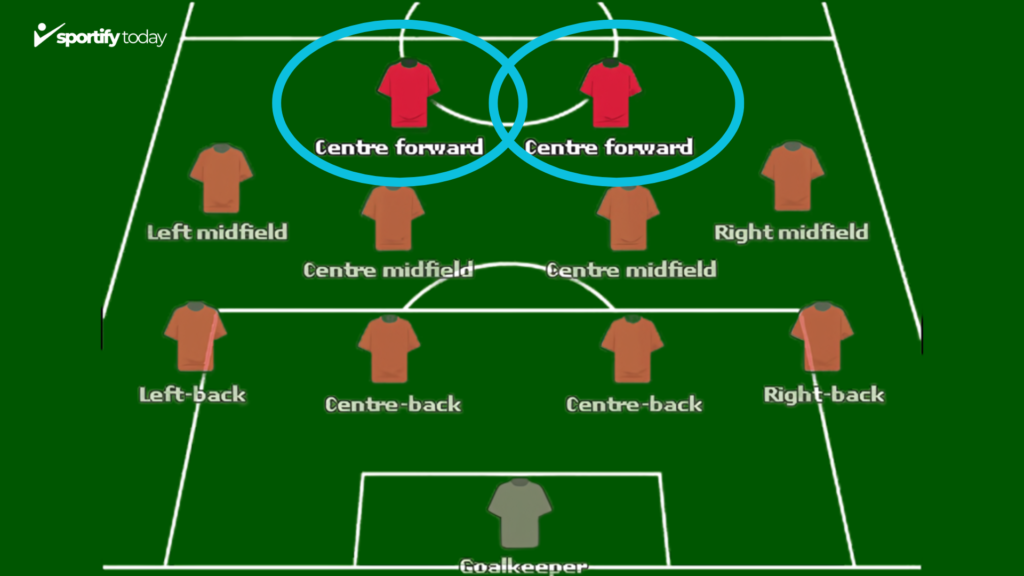
The center forward (CF) is positioned centrally in the attacking line, often acting as the main goal scorer for the team. They are responsible for finishing scoring opportunities, holding up play to involve teammates, and creating space by drawing defenders away from the goal.
- Role: Positioned centrally in the attacking line, often acting as the main goal scorer.
- Key Responsibilities:
- Finish scoring opportunities and convert chances into goals.
- Hold up play to bring wingers and midfielders into the attack.
- Create space for teammates by drawing defenders away.
11. Striker (ST)

The striker (ST) is positioned centrally and primarily focuses on scoring goals, making them the team’s main attacking threat. They are skilled at finishing chances created by teammates, making runs behind the defense to receive through balls, and pressing opposition defenders when out of possession.
Role: Positioned centrally, primarily responsible for scoring goals.
- Key Responsibilities:
- Finish chances created by teammates.
- Make runs behind the defense to receive through balls.
- Press the opposition’s defenders when out of possession.
Conclusion
Understanding the roles and responsibilities of each position in football is essential for effective teamwork and strategy. This comprehensive position chart provides a clear overview of the 11 positions on the field, helping players and coaches maximize their performance and appreciation of the game.
People also ask
1.What is the role of a number 10 in football?
The tenth position is virtually the attacking midfielder whose role entails that he connects the defenders, the midfielders and the forwards. However, the number 6 and 8 roles are very important because they are moving the team’s engine.
2.What is the role of the number 11 position in soccer?
The number 11 position in soccer typically refers to the left winger, who is responsible for attacking down the left flank, delivering crosses, and creating goal-scoring opportunities. This player uses speed and dribbling skills to beat defenders, cut inside for shots, and support the center forward in the attacking phase.
3.What is the role of the number 8 position in football?
The number 8 position in football usually refers to the central midfielder, who plays a crucial role in linking defense and attack. This player is responsible for controlling the tempo of the game

Leave a Reply